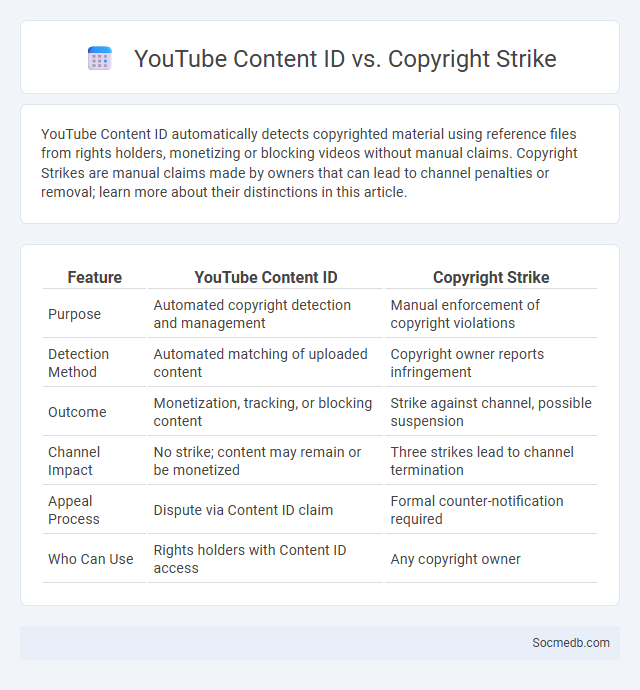
Photo illustration: YouTube Content ID vs Copyright Strike
YouTube Content ID automatically detects copyrighted material using reference files from rights holders, monetizing or blocking videos without manual claims. Copyright Strikes are manual claims made by owners that can lead to channel penalties or removal; learn more about their distinctions in this article.
Table of Comparison
| Feature | YouTube Content ID | Copyright Strike |
|---|---|---|
| Purpose | Automated copyright detection and management | Manual enforcement of copyright violations |
| Detection Method | Automated matching of uploaded content | Copyright owner reports infringement |
| Outcome | Monetization, tracking, or blocking content | Strike against channel, possible suspension |
| Channel Impact | No strike; content may remain or be monetized | Three strikes lead to channel termination |
| Appeal Process | Dispute via Content ID claim | Formal counter-notification required |
| Who Can Use | Rights holders with Content ID access | Any copyright owner |
Understanding YouTube Content ID
YouTube Content ID is an advanced digital rights management system designed to help creators protect their original content by automatically identifying and managing copyrighted material uploaded by other users. By scanning videos for copyrighted audio and visual elements, it allows rights holders to monetize, block, or track unauthorized uses of their work. Understanding how Content ID functions empowers you to safeguard your intellectual property and optimize your channel's revenue streams effectively.
What Is a Copyright Strike on YouTube?
A copyright strike on YouTube occurs when content uploaded violates another party's intellectual property rights, leading to a formal complaint and possible removal of the video. Receiving a copyright strike can restrict your channel's features, suspend monetization, and in severe cases, result in channel termination if multiple strikes accumulate. YouTube uses Content ID and manual claims to identify infringements and protects the rights of original creators through this enforcement mechanism.
Key Differences: Content ID vs Copyright Strike
Content ID is an automated system on platforms like YouTube that scans uploaded videos for copyrighted material and allows rights holders to monetize, block, or track such content without removing it. A copyright strike, however, is a more severe enforcement action that results from a formal DMCA takedown notice, potentially leading to channel suspension after multiple strikes. While Content ID offers rights holders control over their content usage with monetization options, a copyright strike is a legal enforcement tool that directly impacts a creator's account standing and content availability.
How Content ID Works on YouTube
Content ID on YouTube automatically scans uploaded videos against a vast database of copyrighted audio and visual material, identifying matches within seconds. When a match is detected, the copyright owner can choose to monetize, block, or track the video, ensuring their rights are enforced without manual review. You can manage disputes and track claims through your YouTube Studio dashboard to maintain control over your content.
Typical Reasons for Receiving a Copyright Strike
Social media platforms enforce copyright strikes to protect intellectual property rights, commonly issued for uploading unauthorized copyrighted videos, music, or images. Users often receive strikes due to sharing content without proper licenses, using copyrighted material in videos, or reposting protected images without permission. These copyright enforcement actions help prevent plagiarism, unauthorized distribution, and infringement claims on sites like YouTube, Facebook, and Instagram.
Consequences of Content ID Claims
Content ID claims on social media can lead to restricted access, demonetization, or removal of your videos, impacting audience reach and revenue generation. These claims often result from copyrighted material usage without proper authorization, causing channel strikes or account suspensions. Understanding the consequences of Content ID claims helps you protect your content and maintain a positive online presence.
Impact of Copyright Strikes on Your Channel
Copyright strikes significantly affect your social media channel's visibility and monetization potential, often leading to video removal and reduced audience reach. Repeated strikes can result in account suspension, limiting your ability to publish content and engage followers. Understanding platform-specific copyright policies and proactively managing content rights is crucial to maintaining channel growth and avoiding legal complications.
Resolving Content ID Claims Step-by-Step
Resolving Content ID claims efficiently involves identifying the disputed content through YouTube's Content ID system and reviewing the claim's details in your YouTube Studio dashboard. You should gather evidence proving your right to use the content, such as licenses or permissions, and submit a formal dispute or request a manual review to contest the claim. Following these steps carefully helps protect your channel from unfair strikes and monetization issues while maintaining compliance with copyright policies.
Preventing Copyright Strikes and Content ID Issues
Protect Your social media presence by understanding the nuances of copyright law and using original or licensed content to prevent copyright strikes and Content ID issues. Monitor uploads regularly with Content ID tools to identify and resolve potential infringements before they escalate. Implementing clear content policies and securing proper permissions ensures smoother channel growth and avoids legal complications.
Frequently Asked Questions: Content ID vs Copyright Strike
Content ID is an automated system used by platforms like YouTube to identify and manage copyrighted material in uploaded videos, allowing rights holders to monetize, track, or block content. A Copyright Strike occurs when a rights owner formally claims infringement, potentially leading to account penalties or suspension after repeated strikes. Unlike Content ID claims, which are often resolved through revenue sharing or video blocking, Copyright Strikes have more severe consequences for creators' channel status and appeal options.
 socmedb.com
socmedb.com